"Why did you have to choose an enemy that's as old as time and bigger than all of us?" "Same reason you did: I figured I could take him."
Don't wanna be here? Send us removal request.
Text
but to be serious for a bit, i think dark patterns sets out to do what shadow of the bat and legends of the dark knight wanted to do, and ultimately does it better.
its nostalgia for the older style of batman comics going on a case by case basis, but its also something fresh and new.
Sherman's art is insane and wonderfully adds to the life Watters is putting into the comic, which ultimately makes it a living and breathing think worthy of your time.
It is truly a comic where the art elevates the writing and the writing as well elevates the art. There is really nothing like it on shelves right now.
It is another Batman comic, yes, but at the same time I would argue its not. Its not another Batman comic.
Its THE Batman comic.
The comic hitting hard and clearly defining what Batman is and is the definitive Batman currently in print.
54 notes
·
View notes
Text
You just fundamentally cannot carve Jor-El and Lara away from Superman. You need them and you need the Kents. You need them both. Superman is of two worlds, two cultures. This is the source of the lonely melancholy at the heart of Superman’s character. He was so desperately loved by two good-hearted, brilliant people who could not stand to see their son burn with their world, and so they worked until the final moments of Krypton’s life to find a way to ensure that he would make it, that he would survive, that the best of Krypton, the gold in Krypton, would live in him, that he would reach a place where he could be loved as they had loved him, by two good-hearted, earnest people.
"They can be a great people, Kal-El, they wish to be. They only lack the light to show the way. For this reason above all, their capacity for good, I have sent them you... my only son.”
29 notes
·
View notes
Text
I think part of what I do enjoy in some Captain America comics (despite, y'know.) *is* his erroneous idealism, the gap between what he thinks he represents and what he actually does, and the moments where he recognizes that gap vs. where he doesn't. (see excerpt from Camp/Frigeri/Blee's Ultimates below.)
A lot of my favorite cape-fiction characters occupy this psychologically complex position of being in some way emotionally or personally admirable, but tragically flawed or otherwise limited by the circumstances of their existence, because if they reconciled their psychological problems they would cease to exist. they would no longer function as the kind of serialized pulp or soap character that they are. Batman's idealism is both admirable and deeply, childishly sad, a fundamentally unwinnable mission; Magneto's combination of survivor's guilt and messianic personalism is both a blessing and curse upon the social movements he's devoted his life to; Spider-Man's whole career as a superhero is premised upon his own misplaced guilt and self-loathing and sublimated rage.
but by the same token, this ambiguity is also exactly what makes Cap effective propaganda for US cultural and political hegemony, because it perpetuates the notion that there is some ideal version of US nationalism, of the American "project" - taken in-universe to be an expression of a universal aspiration towards freedom, self-ownership, etc. - floating out there, which you can strain the malevolent parts out of. that's what the character is!
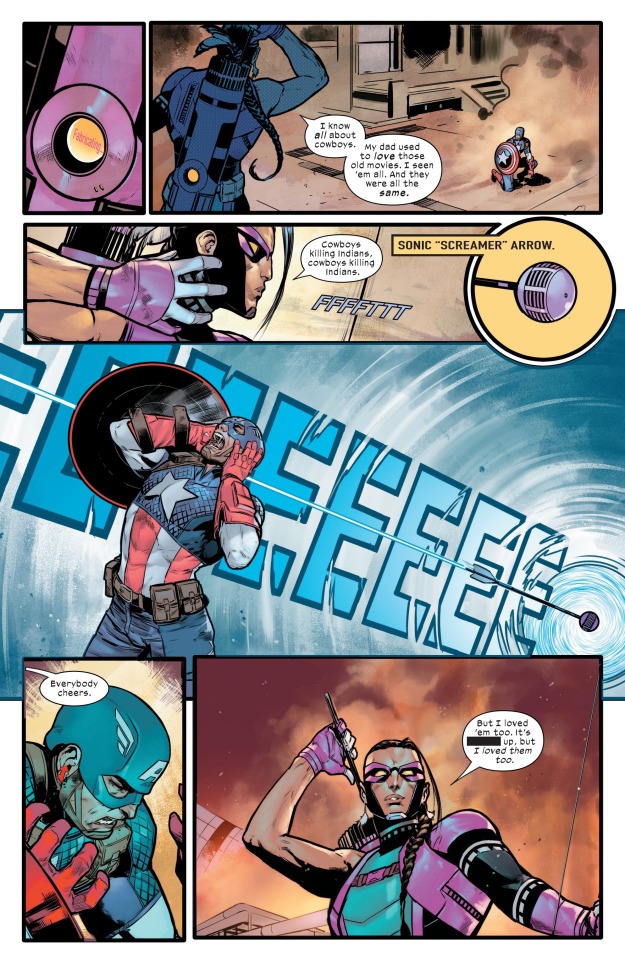
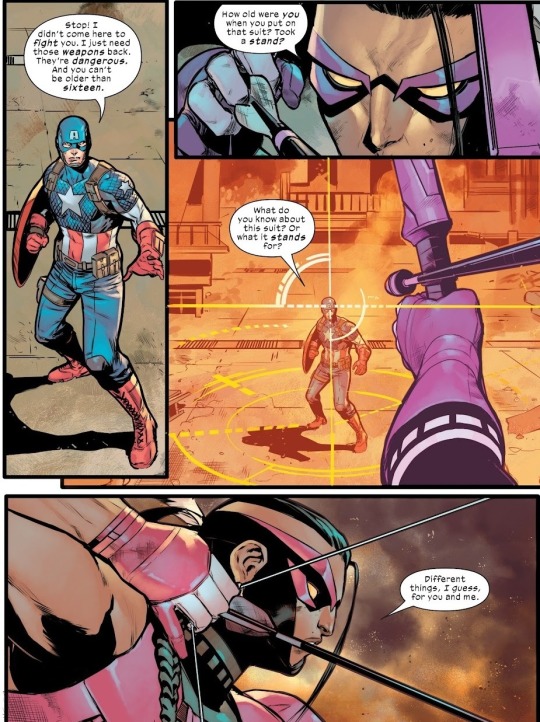
104 notes
·
View notes
Text
the kids today don't know about the classic Batman story Dark Knight, Dark City by Peter Milligan and Kieron Dwyer
1 note
·
View note
Text
Comic Log: May Reads
Pretty busy month, didn't finish very many series.
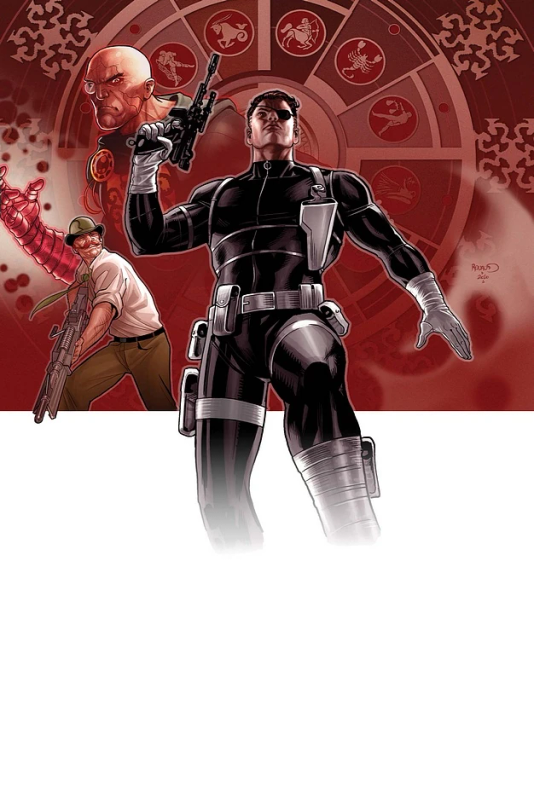
Secret Warriors by Jonathan Hickman: Nick Fury, an international outlaw in the wake of the various Marvel events of the 2000s, wages a covert war against the forces of Hydra and Leviathan, employing his old Howling Commandos and a group of young metahuman unknowns to do the job.
This is a "dudes rock" comic, pure and simple, and if that's the sort of thing you enjoy there's plenty to like. But although I thought the first couple arcs were solid, it eventually lost some of its spark. There's a lot of cool concepts: the three-way war between Nick Fury, Hydra and the Hand, and Leviathan; the titular "Secret Warriors" of the White Team; the triple agent Countess Allegra. But none of these things get enough development or really even many moments to shine, and I do think it tacitly engages in full-throated US nationalism in a surprisingly uncritical way. The comic reminds us over and over again that Nick Fury is the coolest but most morally compromised guy, and that he may be a dirtbag but gets the job done. For a while that's entertaining, but it offers diminishing returns to me, and from Hickman it's superficial. What's worse is that I think the series itself adopts Fury's attitude of treating his pawns as expendable - we never really get to know the other characters as well as I would like. The series is only really elevated by a its very non-linear and spiral-like structure. It's what Grayson thinks it is.
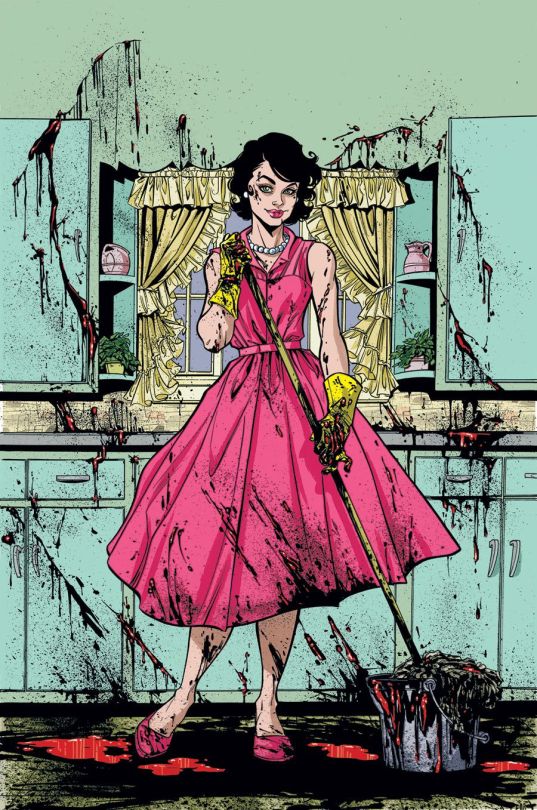
Lady Killer by Joelle Jones: Josie Schuller struggles to find the balance between her life as a suburban housewife and her "volunteer work" as an assassin-for-hire, especially when her bosses start questioning her dedication.
An interesting read! It is sort of about work-life balance in the context of a 1960s setting, like if Norman Rockwell paintings were populated with pinup models, sleazy spies, and slashers. It never rises above pulp action-horror but it is beautifully illustrated with colors by Laura Allred and deep shadows and it does have some interesting ideas about systemic roles. Cool series!
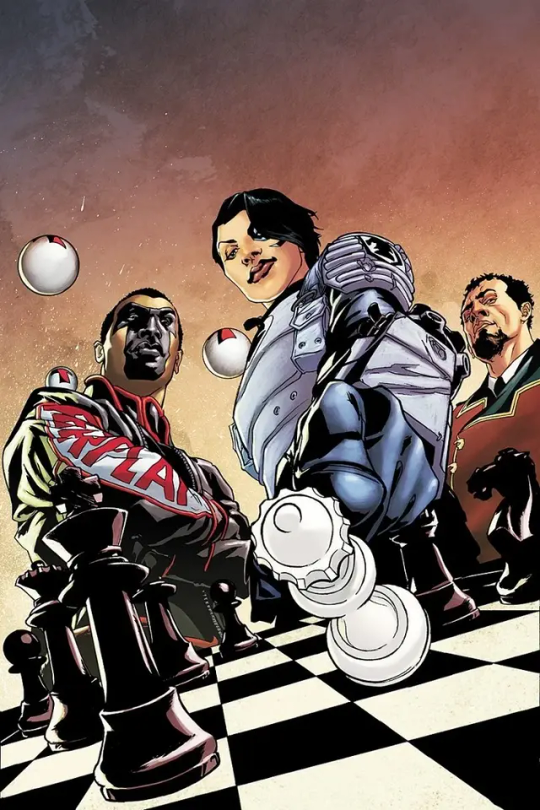
Checkmate by Greg Rucka: The international UN-backed metahuman monitoring spy agency, is kept in balance by its two halves: White and Black, which exist in tension and are often trying to outmaneuver each other for internal control of the organization.
Rucka is always a fun pulp writer and he pulls in a lot of good and underused characters to mesh into this spy drama. Unfortunately I think it's a kind of meandering story. There's like 20% too much focus on the various metahuman threats that Checkmate is grappling with, when the most interesting material is really about the intercenine politics of the espionage organization rather than more traditional "super-spy" stuff. That's where all the meat is, especially at the start of the run. Once Amanda Waller is ousted (with a cliffhanger that doesn't get followed up on, sadly) the series loses its steam. Also one issue is anti-Jacobin propaganda, which annoys me, and throughout it is plagued with all the Orientalism problems that post-9/11 comics really got bogged down in.
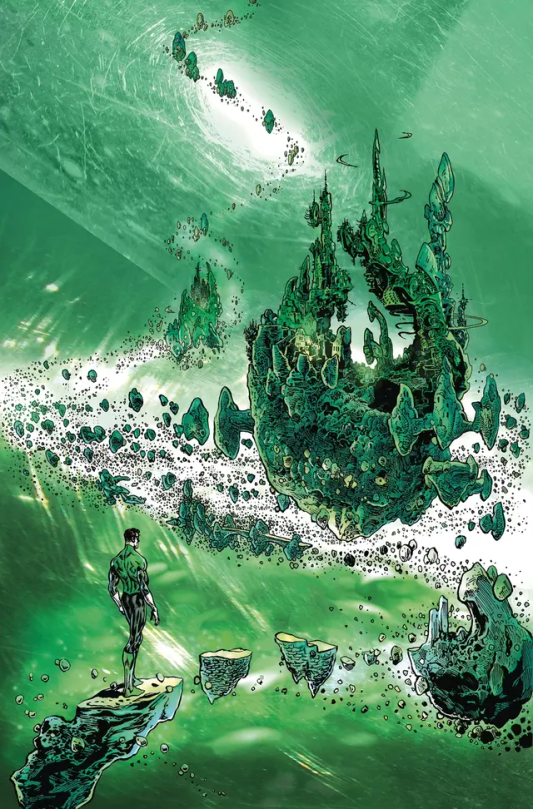
The Green Lantern by Grant Morrison and Liam Sharp
Definitely a high-tier outing from Morrison and also officially my favorite Green Lantern story. Sharp's artwork is great, though it shifts into something closer resembling the heavily digital and "photographic" look of Clayton Crain as the series goes on, whereas I preferred the more densely detailed compositions of the early issues. But in whatever style, Sharp crams in a ton of character and expression and also excellently illustrates some of the more unusual aliens and other members of the Green Lantern Corps (a sentient volcano being a recurring one). Along with JLA it's probably Morrison's most -traditional- cape comic, not in the sense that it's not weird, but in the sense that it's following more typical narrative structures, archetypes, and values. That's pretty appropriate, though, since it's modeled on procedural police fiction - although impressively the series also manages to incorporate elements of horror, romance, and sword-and-sorcery comics. The episodic structure is super enjoyable with a good mixup of different premises, and still manages to tie everything together in a mostly satisfying way. It continues, however, Morrison's frustrating skepticism of ideology.
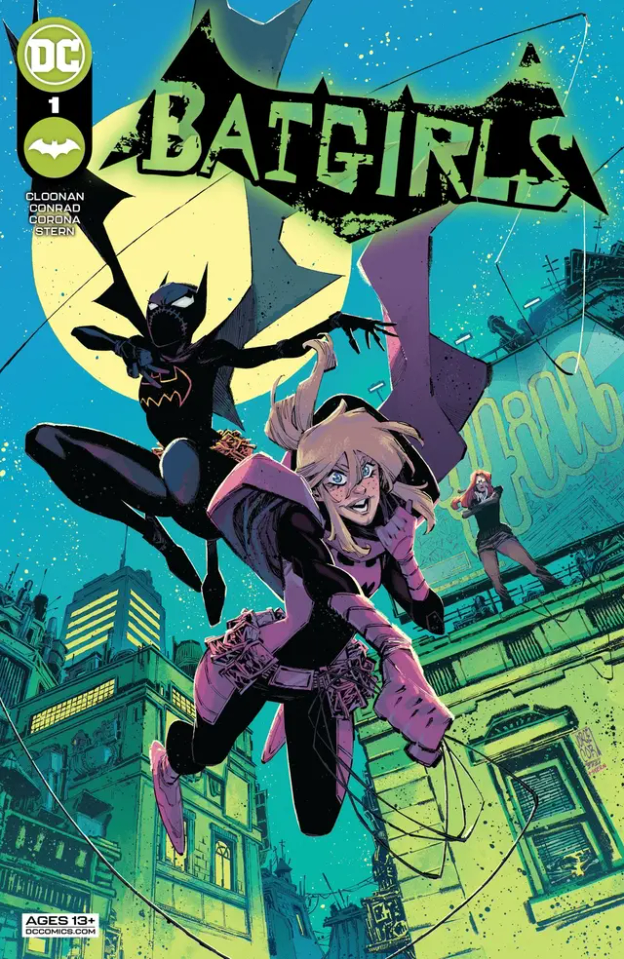
Batgirls by Cloonan and Conrad: Reeling and on the run as a result of a recent Batman event, the three claimants to the Batgirl title set up shop in an old neighborhood to lie low and investigate various mysteries and crimes.
Well, I wanted to like this. The art and colors and shadows really pop and I love the concept and these characters as a trio. But sadly I thought it was a mess, introducing too many story hooks in its first few issues that all have a wildly disparate tone (serial killer, plus killer robots from a big Batman event, plus an evil chuuni Oracle, plus a revolutionary graffiti artist/burglar who is mind-controlling people, PLUS Barbara is being really embarrassing…). And the character writing, which a team-up book like this really leans on, didn’t grab me. The relatively conflict-free and generally light tone of this “Wayne Family Adventures” style is really not my cup of tea, especially for Bat/Gotham series and settings.
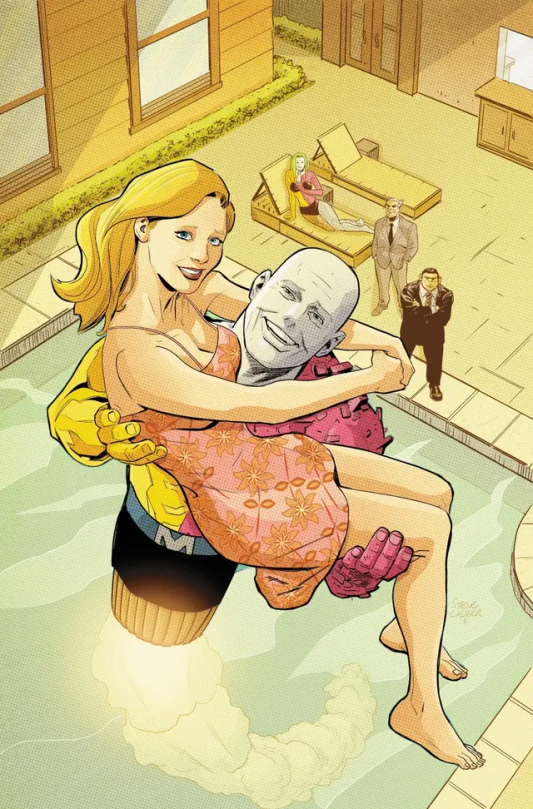
Metamorpho: The Element Man by Al Ewing and Steve Lieber: Hip jetsetting adventurer Rex Mason and a cast of kooky characters get up to various adventures as they try to fend off the sinister CYCLOPS organization, with their interpersonal tensions straining that process.
Ridiculously delightful. Lieber's art is always a treat in this sort of comedically bombastic context (like Superior Foes of Spider-Man or Jimmy Olsen). It's a shame it got canned at six issues, and on a cliffhanger, no less!
1 note
·
View note
Text
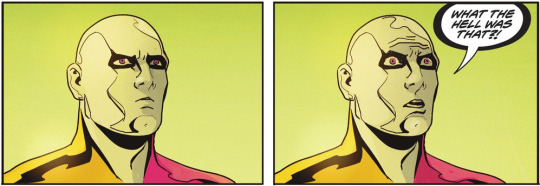


Metamorpho: The Element Man #6 Script by Al Ewing Pencils and inks by Steve Lieber Colors by Lee Loughridge Letters by Ferran Delgado
250 notes
·
View notes
Text
I feel like 100 Girlfriends has a lot of cyclical peaks and valleys as a result of the scope of its ambition
1 note
·
View note
Text
Hey Look At This Comic: Chainsaw Man and Don't Get Around Much Anymore




this title is so funny. hey you probably haven't heard of this small indie comic, yeah it's pretty obscure it's called Chainsaw Man.
here's an even funnier joke: hey have you heard of this comics guy, name of Art Spiegelman?
before Spiegelman wrote that book you probably know him better for (ha ha he he) he did a lot of other comix, particularly a lot of one page experiments. one in particular stuck with me: Don't Get Around Much Anymore, a simple exploration of a narrator's apartment. there's a lot things Spiegelman does to enhance the sense of stasis, isolation, and depressive gloom in this comic, and the New Yorker a while back published a great summary by Spiegelman of his own techniques. what stuck with me the most was the sense of time out of joint created by his manipulation of narrating text and panel contents. throughout the comic, the text and images are "out of synch [sic]". for many panels, the text describes the image we've just seen rather than being illustrated by the panel it's in. there's even a weird pivot in the middle where we briefly look ahead before getting caught again in the backward flow.
because of the kind of person I am, I flashed back to this comic after reading Chainsaw Man issue 172. in it there's a bunch of moments where speech bubbles and panels also seem to be out of sync. so, I dug DGAMA out again and took a look. actually, I did more than reread it: I followed its soundtrack instructions, "to be read to the accompaniment of a dripping faucet, slowly." I'm trying to do more dumb bullshit that artists tell me to do these days because A. it's not like they're going to squirt me with their rubber flower or get me with the ol' ink around the telescope trick, come on and B. we do all kinds of arbitrary, annoying tasks in order to access an intended artistic experience: we call it "video games".
so I went in the bathroom with my girlfriend's copy of Metamaus, found the page where they reproduce DGAMA, and adjusted the faucet. how slowly to drip? well, if it's too low "slowly" becomes "inaudibly" so nudge it up a bit more. ok, tap... tap... couldn't hear that one... tap... good enough. and I read, and when I got to the panel where the narrator's description lines up with the panel contents, "all the water I can use pours out of the faucet with a flick of the wrist," the faucet made the loudest little "plop" yet. damn. A+ Art.
the reading experience is something like this: where a comic might often get chewed up fast, eyes rushing across the page, this one encourages a kind of juddering, halting back and forth between panels. it's almost got a hypnotic quality, paired with the dripping tap. it's such a simple page, but I found myself weaving back and forth over it many times in order to make sense of all the relations. the schematic representations at the top of the page take on an almost mocking quality--you can piece together the floor plan and how everything fits together, but doing so just pulls you into the comic deeper.
the effect of disjointed time in Chainsaw Man isn't the same, but there's some parallels. I find that I have to reread Tatsuki Fujimoto's action sequences a lot of the time to figure out just what is happening in them. this could be seen as a flaw but I think creates a deliberate sense of chaos. whatever occurs in Chainsaw Man can be understood, but only after the fact. in the moment events just occur, then we are invited to dissect the aftermath like crime scene investigators.
for that kind of effect, the disorienting pairing of seemingly out of sync words and drawings works perfectly. Fujimoto likes action sequences that don't linger on the tweens, jumping instead from impact to impact to impact. (this contrasts his dialogue scenes which often incorporate pauses and repeated static panels.) in the page here, a devil whose deal I can't be bothered to remember says "I dodged it!" only to realize that their head's been cut off. only, that's not really right, is it? the speech bubble is "I dodged it!" but in the panel the killing blow has already been struck. the speech bubble, as in Spiegelman's comic, seems to be lagging a bit behind the action. look at the two page splash too: if we're inclined to read the action the same way we read the rest of the comic, right to left, we arrive on the right hand of the page, where the action has already completed. we don't follow Chainsaw Man's trajectory but instead focus on where he already is, reconstructing the violence as we pass back across the rest of the page. to me, the skipping of intermediate moments, the page compositions, and this disunity between text and image, invites something similar to the passing back and forth over panels that we see in DGAMA.
is it that deep? if you think about this I suppose you can conclude "this is the character dying before they know it" which, sure, though I think that raises some interesting questions like "how do you get a whole sentence out with a severed windpipe and vocal cords". there's a moment later on when some dude is like "you guys! get behind me!" as, again, the panel shows his head and arms flying off. I guess there's a pretty established convention in manga and anime at this point of allowing gravity to be as weak as it needs, in order to let someone say as much as they want while their limbs are flying off, not unlike opera's convention of having someone get stabbed and then stand up to sing an aria with the sword still sticking out of their lungs.
nevertheless, I think it feels experientially distinct when you have a static image, ostensibly representing a unit of time, and the panel contents are this transparently incompatible. a more interesting way of looking at it is: death comes so fast for these characters that the comic can't keep up. it's not the speech but the speech bubbles that are out of joint here, the action leaving its medium behind. it's a radically different end effect than the one Spiegelman aims for, and is a lot less ready for the cover of The New Yorker, but the underlying principle of decoupling word and image in order to create a sense of time not quite functioning correctly remains the same.
if you wanted to achieve this in film, what could you do? maybe desync the audio track? it's an interesting possibility, though one I think a lot of viewers would experience as a transcoding error rather than an intended effect. or you could do something like the astonishing sequence in the most recent episode of The Elusive Samurai where, like Chainsaw Man, intermediate actions are removed so that a character is abruptly standing next to a bunch of headless corpses blooming blood flowers in slow motion. there's ways to capture something of the energy of Fujimoto's work.
...I don't think the anime adaptation of Chainsaw Man really tries, for the most part. both the slow awkwardness of conversations with their static compositions, and the way the action tends to skip clear movement for noise and destructive aftermath, aren't really suited to the style of high budget blockbuster anime, which wants to pack the screen with little movements, as though to make sure the money is visible with each frame, all the ones accounted for. the adaptation has largely opted to look as good as possible all the time, for a given value of good, in a way that I think loses a lot of the grungy charm of the comic.
even the most suited adaptation, though, would still lack one of the fundamental qualities of the comic page: its altogetherness, its arthrology as Thierry Groensteen terms it, its nature as a bunch of panels in a metaframe, taken in at a glance, or pages easily flipped back and forth across. it's this that allows us to pass back and forth over the page like we're reconstructing the calamity from the evidence after the fact.
this post originally ran on Cohost on August 19, 2024. you can read more reviews in the Hey Look At This Comic tag and support me on Patreon.
358 notes
·
View notes
Text











My Strawhat Deck!! (Ofc Vivi is included shes a strawhat TO ME) Been working on these for a while and I'm very happy with how they turned out
I will be turning them into an actual deck of cards btw!!! Very excited to sell them at conventions (More info on my insta @\doodle.list 👀) and eventually online! so keep an out for that hehe
16K notes
·
View notes
Text
100 Girlfriends having like multiple compelling yuri subplots contained within is so crazy to me
1 note
·
View note
Text
I dunno, I love Spidey and MJ but I feel less strongly about them being married than I do about the other elements retconned by One More Day (the identity reveal and May's impending death). I want the relationship to be written well more than I want it to be codified in any particular way. let Spider-Man get divorced and drift in and out of his ex-wife's bed in a self-destructive inability to move past each other, even though they just can't make it work. or, the love is there but the circumstances aren't. something!
but like "well written" is simply something that comic book wives are generally not allowed to be. you can be emotionally complicated and vilified by the audience, or you can be a perfect constantly supportive angel (like Mary Jane is currently being portrayed as in Ultimate Spider-Man, which skews too hard into wish fulfillment for my liking). I like Lois Lane and Linda Park but I don't think either have necessarily always been well-served by being in the roles of wives and mothers. but also, those are supporting cast members for characters whose stories *are* in some way strongly oriented towards a familial life: Superman's combination of compassion and loneliness; The Flash's commitment to legacy and ability to handle multitasking of increasing complexity (while Flash and Spidey have very similar romantic comic structures, I think the former is generally depicted as having a slightly and more consistently better handle on his life).
but Spider-Man is a character who cannot totally fix his personal life under any circumstances. because he is overwhelmed by different responsibilities and the number one out of all of those is helping others in order to assuage his irrational self-hatred. so even if he has a family it sure as hell better not be going emotionally smoothly all the time
Renew Your Vows convinced me that the Peter/MJ dynamic, particularly the marriage/kids, is not necessarily guaranteed to make for a good Spider-Man story
14 notes
·
View notes
Text
Renew Your Vows convinced me that the Peter/MJ dynamic, particularly the marriage/kids, is not necessarily guaranteed to make for a good Spider-Man story
14 notes
·
View notes
Text
Zom100 when the antagonist is the zombies: charming slice-of-life about living life to its fullest in the midst of disaster
Zom100 when the antagonists are other humans: HELLO WE ARE EVIL WE WILL NOW EXPLAIN OUR IDEOLOGY IN GREAT DETAIL TO YOU LIKE IT'S MY HERO ACADEMIA
1 note
·
View note
Text
I can't believe they put out a new Question series and it was bad
2 notes
·
View notes









